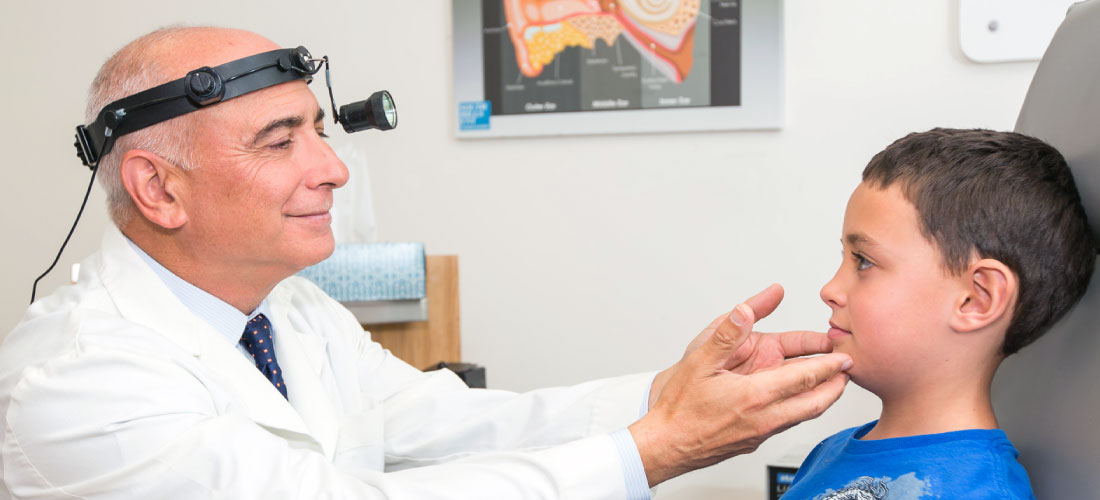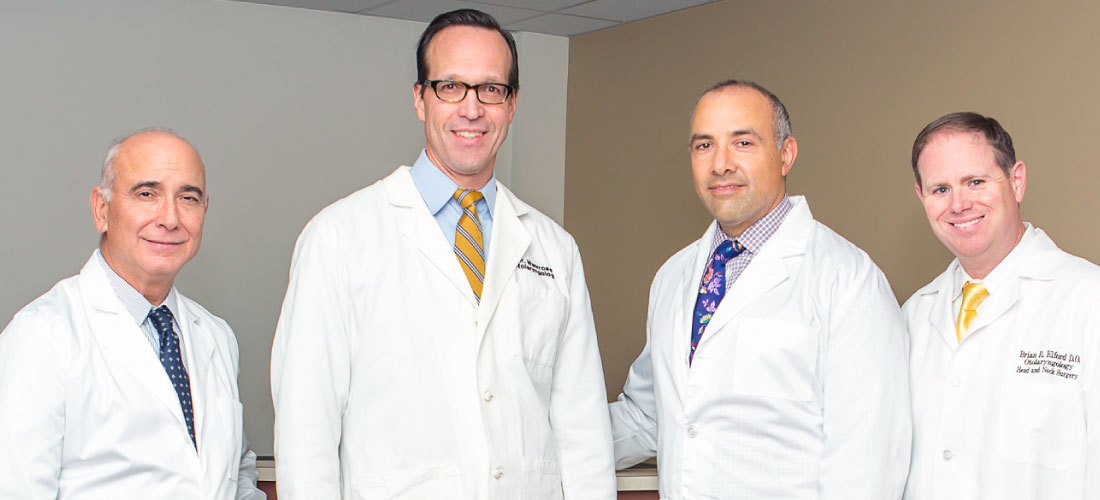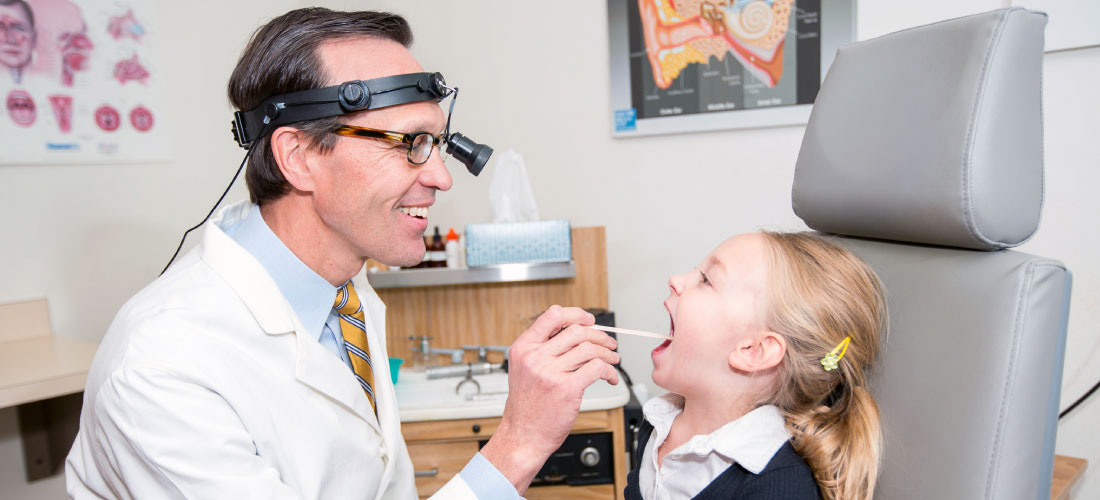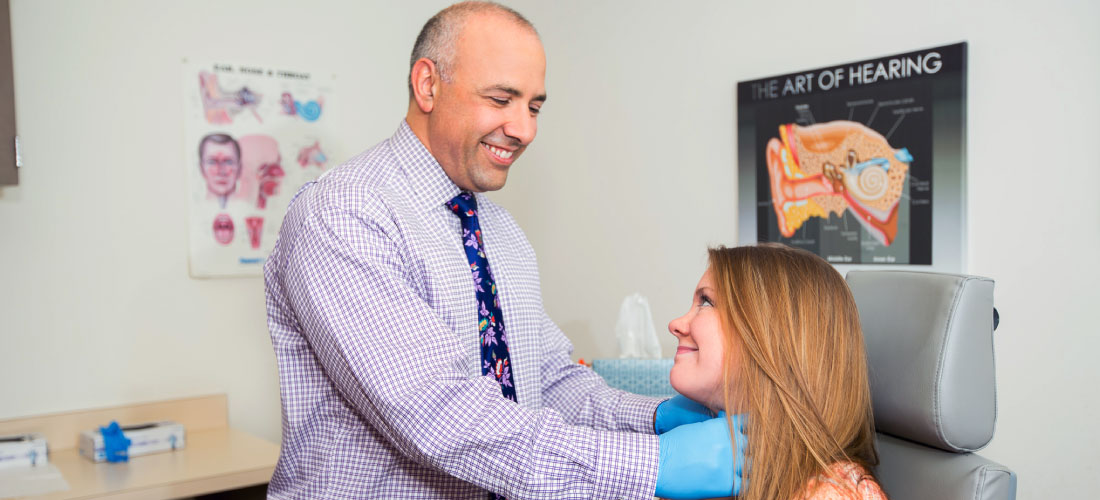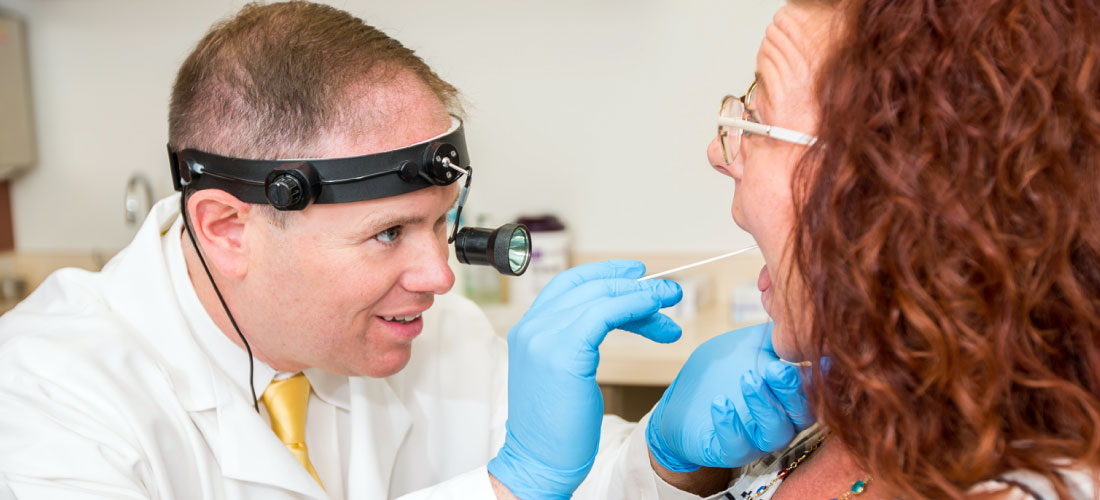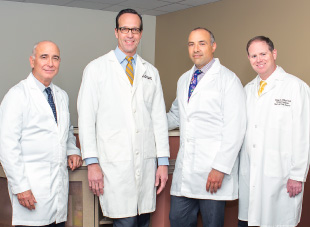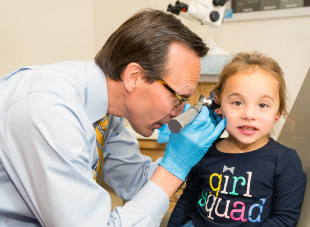Call Us Today
Patient Resources
Head and Neck Cancer
Each year, more than 55,000 Americans will develop cancer of the head and neck (most of which is preventable). Nearly 13,000 will die from cancer of the head and neck.
Head and neck cancers are curable if caught early. Fortunately, most of them produce early symptoms. You should know the potential warning signs so you can alert your physician as soon as possible. Successful treatment of head and neck cancer depends on early detection. Knowing and recognizing its signs can save your life.
What Are the Symptoms of Head and Neck Cancer?
Symptoms of head and neck cancer can include:
- A lump in the neck
- Change in the voice
- A growth in the mouth
- Bringing up blood
- Swallowing problems
- Changes in the skin
- Persistent earache
A lump in the neck—Cancers that begin in the head or neck usually spread to lymph nodes in the neck before they spread elsewhere. A lump in the neck that lasts more than two weeks should be seen by a physician as soon as possible. Of course, not all lumps are cancer. But a lump(s) in the neck can be the first sign of cancer of the mouth, throat, voice box (larynx), thyroid gland, salivary glands, or of certain lymphomas and blood cancers.
Change in the voice—Most cancers in the voice box cause a change in your voice. An ENT (ear, nose, and throat) specialist, or otolaryngologist, can examine your voice box easily and painlessly. If you are hoarse or notice voice changes for more than two weeks, see a physician.
A growth in the mouth—Most cancers of the mouth or tongue cause a sore or swelling that doesn’t go away. These may be painless, which can be misleading. Cancer is often painless. Bleeding may occur, but often not until late in the disease. If an ulcer or swelling is accompanied by lumps in the neck, you should be concerned. In addition, any sore or swelling in the mouth that does not go away after two weeks should be evaluated by a physician.
Bringing up blood—This is often caused by something other than cancer. However, tumors in the nose, mouth, throat, or lungs can cause bleeding. If blood appears in your saliva or phlegm for more than a few days, you should see a physician.
Swallowing problems—Cancer of the throat or esophagus may make swallowing solid foods, and sometimes liquids, difficult. If you have trouble almost every time you try to swallow something, you should see a physician. A barium swallow X-ray or a direct examination of the swallowing tube with a scope, called an esophagoscopy, can help determine the cause.
Changes in the skin—The most common head and neck cancer is basal cell skin cancer. Fortunately, this is rarely serious if treated early. Basal cell cancers appear most often on sun-exposed areas like the forehead, face, and ears, but can occur almost anywhere on the skin. Basal cell cancer often begins as a small, pale patch that slowly grows, producing a central dimple and, eventually, an ulcer. Parts of the ulcer may heal, but the major portion remains ulcerated. Some basal cell cancers show color changes.
Other kinds of cancer, including squamous cell cancer and malignant melanoma, also occur on the head and neck. Most squamous cell cancers occur on the lower lip and ear. They may look like basal cell cancers and are usually not dangerous if caught early and treated properly. If there is a sore on the lip, lower face, or ear that does not heal, see a physician. Malignant melanoma typically produces a blue-black or black discoloration of the skin. However, any mole or spot that changes size or color, or begins to bleed, should be seen as soon as possible by a dermatologist or other physician.
Persistent earache—Constant pain in or around the ear when you swallow can be a sign of infection or tumor in the throat. This is particularly serious if you also have difficulty swallowing, a hoarse voice, or a lump in the neck, and should be evaluated by an ENT specialist.
What Causes Head and Neck Cancer?
Head and neck cancers occur due to prolonged exposure to specific risk factors, such as tobacco use (e.g., cigarettes, cigars, chewing tobacco, or snuff), excessive alcohol abuse, or exposure to HPV. Cancer of the lip may be caused by prolonged exposure to sunlight, and is also a major cause of skin cancer.
What Are the Treatment Options?
Treatment options depend on several factors, such as the stage of disease, type and location of the tumor, and the patient’s overall health. Treatment options for cancer are best discussed in a multi-disciplinary setting involving the surgeon, radiation oncologist, oncologist, pathologist, radiologist, speech and swallowing experts, as well as the patient and caregivers. Treatment options may include:
Surgery—The goal of cancer surgery is to remove the cancerous tissue and a ring of normal tissue around it. The surgery may also include removing lymph nodes from the neck. Reconstructive plastic surgery may be needed if the cancer is widespread and requires extensive tissue removal. These may include surgery to the tongue, jawbone, facial skin, pharynx, or larynx. In cases such as this, tissue from other parts of the body, like the forearm or leg, can be transplanted to give patients the best possible cosmetic and functional outcomes.
Radiation therapy—High energy X-rays are used to stop the growth of and kill cancer cells. Depending on the type and stage of cancer, radiation can be used as a stand-alone treatment or given after surgery with or without chemotherapy. A commonly used form of radiation therapy is intensity-modulated radiation therapy (IMRT), which concentrates radiation beams to the tumor while minimizing damage to the surrounding healthy cells.
Systemic therapy—Chemotherapy is the most common type of systemic therapy and destroys cancer cells through the bloodstream using one drug or a combination of drugs. Chemotherapy is often used in combination with radiation therapy either concurrently as primary treatment or after surgery as supplemental treatment. These medications are given in fixed doses as determined by the medical oncologist who monitors the response to treatment and any potential adverse reactions.
Immunotherapy improves the body’s immune system and helps fight cancer cells. This rapidly growing area of treatment options has shown promise in patients with recurrent or widely spread (metastatic) cancers. Pembrolizumab (KEYTRUDA®) and nivolumab (OPDIVO®) are examples of FDA-approved immunotherapeutic drugs for head and neck cancers.
What Questions Should I Ask My Doctor?
- What is the stage of my cancer?
- I have heard about HPV causing cancer of the tongue and/or tonsil. Is my cancer related to the virus?
- Will surgery cause disfiguration?
- Will I need any additional treatment like radiotherapy or chemotherapy?
- Will surgery affect my ability to speak or swallow?
- What are the side effects of this treatment?
- How long may I have to be in the hospital?
- What are the chances that the cancer will come back?
- Should I seek a second opinion?
Graves’ Disease
The thyroid is a butterfly-shaped gland located at the base of the front of the neck. It produces thyroid hormone, which controls your metabolism, temperature regulation, and keeps your muscles and organs working properly. Graves’ disease causes the thyroid gland to become overactive. It is an autoimmune disease in which the body fights against itself and causes the thyroid gland to become overactive. It is more common in women, but can also can occur in men.
What Are the Symptoms of Graves’ Disease?
The symptoms of Graves’ disease include:
- Racing heartbeat
- Anxiety
- Weight loss
- Tremors
- Feeling warm
- Difficulty sleeping
- Bulging eyes
- Eye redness
- Double vision, or decreased vision
- Thickening of the skin in front of the shins
A blood test is used to diagnose Graves’ disease. A measurement of the thyroid stimulating hormone (TSH) is low in Graves’ disease. The levels of thyroid hormone, such as T3 and T4, are high in Graves’ disease. Measuring antibodies called TSI or TRAb also help confirm the diagnosis. Sometimes, a “radioactive iodine uptake study” is used to confirm the diagnosis of Graves’ disease.
What Causes Graves’ Disease?
Graves’ disease is an autoimmune disorder in which the body produces inflammation of the thyroid gland causing it to be overactive. The specific cause is unknown but may occur at higher rates in certain families.
What Are the Treatment Options?
Treatment for Graves’ disease includes daily medications, radioactive iodine, or thyroid surgery. Medications can be used for several months to try and control (but not cure) the hyperthyroidism. If the medications do not control the disease, surgery or radioactive iodine may be necessary. Radioactive iodine and surgery are used to manage the disease, but can cause the thyroid to be underactive and you must then take medication to replace the thyroid hormone.
Therapy depends on the presence of eye symptoms, the presence and size of thyroid nodules, and your preferences. Surgery is generally considered if the thyroid also has nodules, the gland is very large, the patient has eye disease (which may worsen if radioactive iodine is given), or if the patient wants to avoid radioactive iodine.
What Questions Should I Ask My Doctor?
- Do I have thyroid nodules or a goiter? What’s the difference, and how does that affect treatment?
- Do you have expertise in thyroid surgery? Can you tell me about your training?
- How effective are medications and what are the risks?
Goiter
The thyroid is a butterfly-shaped gland located at the base of the front of the neck. It produces thyroid hormone, which controls your metabolism, temperature regulation, and keeps your muscles and organs working properly.
Goiter refers to an enlarged thyroid gland. A single or multiple nodules, Graves’ disease, and hyperthyroidism can all lead to the development of a goiter. A goiter can develop in one or both sides of the thyroid gland. In some people, the goiter will start to grow down into the chest. This is referred to as a substernal goiter.
What Are the Symptoms of Goiter?
Goiters can often be seen or felt as a lump or mass in the neck. As goiters become bigger they can put pressure on your windpipe (trachea) or food pipe (esophagus), causing symptoms such as:
- Difficulty swallowing
- Difficulty breathing (particularly when lying down)
- Choking sensation
- Pressure in the neck
What Causes Goiter?
In some parts of the world, goiters develop because of a lack of iodine in peoples’ diets. However, in the United States where iodine is added to salt, goiters are most often caused by other problems. A family history of goiter increases the risk of developing goiter.
What Are the Treatment Options?
When a patient starts to experience symptoms, treatment is often offered. The exact type of treatment is based on the cause of the goiter and the patient’s preferences. In some cases, thyroid surgery is the best treatment option. Discuss any possible symptoms or concerns you may have with your primary care provider, an endocrinologist, or an ENT (ear, nose, and throat) specialist, or otolaryngologist.
What Questions Should I Ask My Doctor?
- I have difficulty breathing or swallowing. Could this be related to a goiter?
- How big is my goiter?
- Do I need to treat it, or can I just watch it?
GERD and LPR
Acid reflux occurs when acidic stomach contents flow back into the esophagus, the swallowing tube that leads from the back of the throat to the stomach. When acid repeatedly “refluxes” from the stomach into the esophagus alone, it is known as gastroesophageal reflux disease (GERD). However, if the stomach acid travels up the esophagus and spills into the throat or voice box (called the pharynx/larynx), it is known as laryngopharyngeal reflux (LPR).
While GERD and LPR can occur together, people sometimes have symptoms from GERD or LPR alone. Having symptoms twice a week or more means that GERD or LPR may be a problem that could be helped by seeing a doctor.
What Are the Symptoms of GERD and LPR?
Many patients with LPR do not experience classic symptoms of heartburn related to GERD. And sometimes, adult patients may experience symptoms related to either GERD or LPR like:
- Heartburn
- Belching
- Regurgitation (a surge or rush back) of stomach contents
- Frequent throat clearing or coughing
- Excess mucus
- A bitter taste
- A sensation of burning or throat soreness
- Something “stuck” or a “lump” in the back of the throat
- Hoarseness or change in voice
- Difficulty swallowing
- Drainage down the back of the nose (post-nasal drip)
- Choking episodes (can sometimes awaken from sleep)
- Difficulty breathing, if the voice box is affected
Signs in infants and children are different from adults and may include:
- Breathing problems such as a cough, hoarseness, noisy breathing, or asthma
- Pauses in breathing (apnea) or snoring when sleeping
- Feeding difficulty (spitting up)
- Turning blue (cyanosis)
- Choking
- Apparent life-threatening event where there is arching of the back while in distress
- Trouble gaining weight or growing
What Causes GERD and LPR?
GERD and LPR can result from physical causes and/or lifestyle factors. Physical causes can include weak or abnormal muscles at the lower end of the esophagus where it meets the stomach, normally acting as a barrier for stomach contents re-entering the esophagus. Other physical causes include hiatal hernia, abnormal esophageal spasms, and slow stomach emptying. Changes like pregnancy and choices we all make daily can cause reflux as well. These choices include eating foods like chocolate, citrus, fatty foods, spicy foods or habits like overeating, eating late, lying down right after eating, and alcohol/tobacco use (see below).
GERD and LPR in infants and children may be related to causes mentioned above, or to growth and development issues.
What Are the Treatment Options?
Your primary care provider or pediatrician will often refer you to an ENT (ear, nose, and throat) specialist, or otolaryngologist, for evaluation, diagnosis, and treatment if you are having related symptoms.
GERD and LPR are usually suspected based on symptoms, and can be further evaluated with tests such as an endoscopic examination (a tube with a camera inserted through the nose), biopsy, special X-ray exams, a 24-hour test that checks the flow and acidity of liquid from your stomach into your esophagus, esophageal motility testing (manometry) that measures muscle contractions in your esophagus when you swallow, and emptying of the stomach studies. Some of these tests can be performed in an office.
Options for treatment include lifestyle and dietary modifications (see below), medications, and rarely surgery. Medications that can be prescribed include antacids, ulcer medications, proton pump inhibitors, and foam barrier medications. To be effective, these medications are usually prescribed for at least one month, and may be tapered off later after symptoms are controlled. For some patients, it can take two to three months of taking medication(s) to see effects.
Children and adults who do not improve with medical treatment may require surgical intervention. Surgical treatment includes “fundoplication,” a procedure that tightens the lower esophageal muscle gateway (lower esophageal sphincter, or LES). Newer techniques allow this to be done in an endoscopic or minimally invasive manner. Another surgical option uses magnetic beads to tighten the LES.
What Changes Can I Make to Prevent GERD and LPR?
For adults, you can take certain steps to reduce or prevent occurrences of GERD and LPR, including:
- Lose weight.
- Cut down or stop smoking tobacco products.
- Limit or avoid alcohol.
- Wear clothing that is looser around the waist.
- Eat three to four small meals a day, instead of two to three large ones, and eat slowly.
- Avoid eating and drinking within two to three hours of bedtime.
- Limit problem foods, such as caffeine, carbonated drinks, chocolate, peppermint, tomatoes, citrus fruits, fatty and fried foods, and/or spicy foods.
What Questions Should I Ask My Doctor?
- Can I take over-the-counter medications to help control my acid reflux?
- What other steps can you recommend that I take to reduce or limit acid reflux?
- Is acid reflux an indication of a larger problem?



